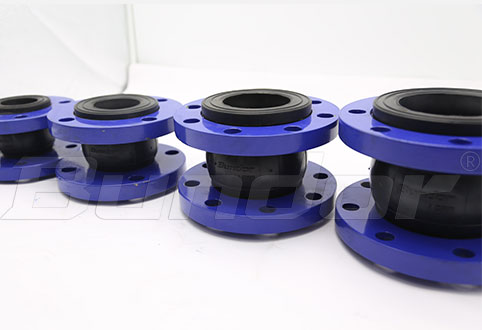Flexible joint rubber manufacturers
Posted by Bundor valve
The Flexible joint rubber is divided into three types: loose sleeve flange type, fixed flange type and threaded type according to the connection mode.According to the structure, it can be divided into five kinds, such as single sphere, double sphere, reducing body, bent sphere and wind pressure coil.By the inner and outer layers of glue, cord layer and wire ring composed of tubular rubber parts, after vulcanization molding and then combined with the metal flange or parallel joint loose sleeve.This product can reduce the vibration and noise, and can compensate for the thermal expansion and cold contraction caused by the temperature change. It is widely used in various pipeline systems.

Flexible joint rubber manufacturers recommend B&D valve for you, the advantages of its Flexible joint rubber are:
1. The radian of flange inner forging surface is R=67°, which reduces the damage caused by friction between flange and rubber ball by more than 95%.
2. Flange paint processing, not easy to rust in wet environment.
3. The 1*45 chamfering of the bolt hole improves the tightness of the connection by 10%.
Flexible joint rubber flange adopts pure national standard flange, the service life is increased more than 5 years.
5. The rubber ball is made of EPDM rubber, which contains more than 40% rubber and has longer service life than conventional rubber.
6. The number of lining layers of rubber ball and sphere exceeds the national standard.
7. Rubber ball with steel wire, distortion resistance, seismic coefficient increased by 10%.
8. The thickness of both ends of rubber ball should be increased by 10mm, and steel ball should be added to prevent the ball from pulling off.
9. The end face of rubber ball connection is made of German waterline, and the sealing effect is improved by 30%.
10. The ball is processed by one process to ensure the smoothness of the inner wall and the ball pressure.

Flexible joint rubber manufacturers recommend B&D valve for you, the advantages of its Flexible joint rubber are:
1. The radian of flange inner forging surface is R=67°, which reduces the damage caused by friction between flange and rubber ball by more than 95%.
2. Flange paint processing, not easy to rust in wet environment.
3. The 1*45 chamfering of the bolt hole improves the tightness of the connection by 10%.
Flexible joint rubber flange adopts pure national standard flange, the service life is increased more than 5 years.
5. The rubber ball is made of EPDM rubber, which contains more than 40% rubber and has longer service life than conventional rubber.
6. The number of lining layers of rubber ball and sphere exceeds the national standard.
7. Rubber ball with steel wire, distortion resistance, seismic coefficient increased by 10%.
8. The thickness of both ends of rubber ball should be increased by 10mm, and steel ball should be added to prevent the ball from pulling off.
9. The end face of rubber ball connection is made of German waterline, and the sealing effect is improved by 30%.
10. The ball is processed by one process to ensure the smoothness of the inner wall and the ball pressure.
 简体中文
简体中文 Русский
Русский Español
Español Bundor - Butterfly, Gate, Check, Ball, Globe Valve Manufacturer, Supplier & Distributor
Bundor - Butterfly, Gate, Check, Ball, Globe Valve Manufacturer, Supplier & Distributor
